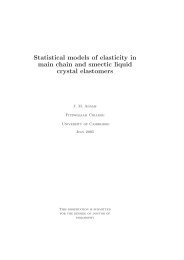Zephyr: A High Altitude Long Endurance Unmanned Air Vehicle ...
Zephyr: A High Altitude Long Endurance Unmanned Air Vehicle ...
Zephyr: A High Altitude Long Endurance Unmanned Air Vehicle ...
- No tags were found...
Create successful ePaper yourself
Turn your PDF publications into a flip-book with our unique Google optimized e-Paper software.
After the tests were completed successfully, I decided to test the sensor further byleaving it in the chamber overnight at -100C with the servo constantly moving thevane. This would enable us to find if the sensor would be able to endure constantmovement at such a cold temperature. The sensor would never have conditions thisharsh on the aircraft so if it managed to survive the overnight test it would giveconfidence that it would definitely work onboard the aircraft.After 15 hours at -100°C, the vane was still working and still outputting the correctvoltages. It was then switched off to see if the potentiometer would freeze when not inuse (the original sensor lost contact due to the freezing of the lubricant) and thenswitched on again to see if it would lose contact, but again it performed perfectly.Once all the tests had been completed and the sensor being tested was removed fromthe chamber, the sensor was examined to see if it had suffered any wear. It was notedthat there was no damage to any part of the equipment, and even though there was nolubricant between the brush and the track, there was no damage to the resistive track.4.4 ConclusionAfter testing the modified angle of attack sensor, it was concluded that it performedbetter than the original sensor and does not lose contact (which would have caused thevoltage to spike to 0V). With that in mind, it was recommended that the modifiedsensor should be used instead of the original angle of attack sensor onboard <strong>Zephyr</strong>.53
















